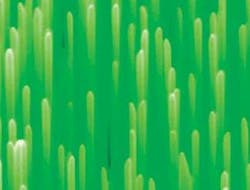NANOTECHNOLOGY: Complementary zinc oxide nanowires may yield cheaper LEDs and solar cells
Before the development of gallium nitride (GaN) blue light-emitting-diodes (LEDs) by Shuji Nakamura, zinc oxide (ZnO) was broadly studied as a possible material for blue emitters for LEDs. That interest has returned, and recently reported results from the University of California San Diego (UCSD) indicate that one previously prohibitive concern has been overcome. Deli Wang at UCSD’s Jacobs School of Engineering, along with colleagues at UCSD and Peking University (Beijing, China), have reported synthesis of high-quality p-type zinc oxide nanowires (see figure).1
Zinc oxide is cheaper than GaN, even for thin-film materials fabricated using metal-organic chemical-vapor deposition (MOCVD), because there is no need for handling the toxic ammonia associated with GaN fabrication, there are cheaper substrates for thin-film growth, and ZnO offers the potential to grow nanostructures (for creating nanoscale optoelectronics, for instance) from a solution phase instead of a gas phase.
Fabrication of functional devices, however, requires a material with complementary doping (p and n). The easiest materials to work with have equal p and n unintentionally or intrinsically doped within them, enabling users to simply tune p or characteristics for specific applications, Wang said.
In its natural state, ZnO is “unintentionally” doped to n-type by naturally occurring oxygen vacancies, however, and as with all wide-bandgap semiconductors, it is hard to dope it away from its natural state. “You need to introduce p-type impurities,” Wang said. “But effective dopants tend to take up residence at a deep level in the material and become hard to activate.”
To make the p-type ZnO nanowires, Wang’s team doped ZnO crystals with phosphorus pentoxide using a chemical-vapor-deposition technique, simpler and less expensive than the MOCVD technique used to fabricate GaN LEDs. Adding phosphorus atoms to the ZnO crystal structure leads to p-type semiconducting materials through the formation of a defect complex that increases the number of holes relative to the number of free electrons.
Although p-type thin films have been developed in ZnO, the UCSD group continued to use nanowires. Doping is more difficult at the nanoscale, however, because quantum effects tend to expel impurities. At 50 to 100 nm in diameter, though, the nanowires are much larger than quantum dots, which are extremely hard to dope, Wang said. Nanowire LEDs offer potentially higher light-extraction efficiency than planar structures because they could potentially eliminate losses due to total internal reflection.
“Zinc oxide nanostructures are incredibly well-studied because they are so easy to make. Now that we have p-type zinc oxide nanowires, the opportunities for LEDs and beyond are endless,” said Wang. He has filed a provisional patent for p-type ZnO nanowires and his lab at UCSD is currently working on developing nanowire-based LEDs and solar cells.
“Having p-type ZnO nanowires for electronics enables complementary doping of devices and makes many nanoscale optoelectronic device R&D possible,” Wang said. “There is also a lot of work being done on a nanoscale laser. Without p-type, you can’t have an injection nanolaser.”
REFERENCE
1. B. Xiang et al., Nano Letters, DOI: 10.1021/nl062410c (December 29, 2006).
About the Author
Hassaun A. Jones-Bey
Senior Editor and Freelance Writer
Hassaun A. Jones-Bey was a senior editor and then freelance writer for Laser Focus World.
